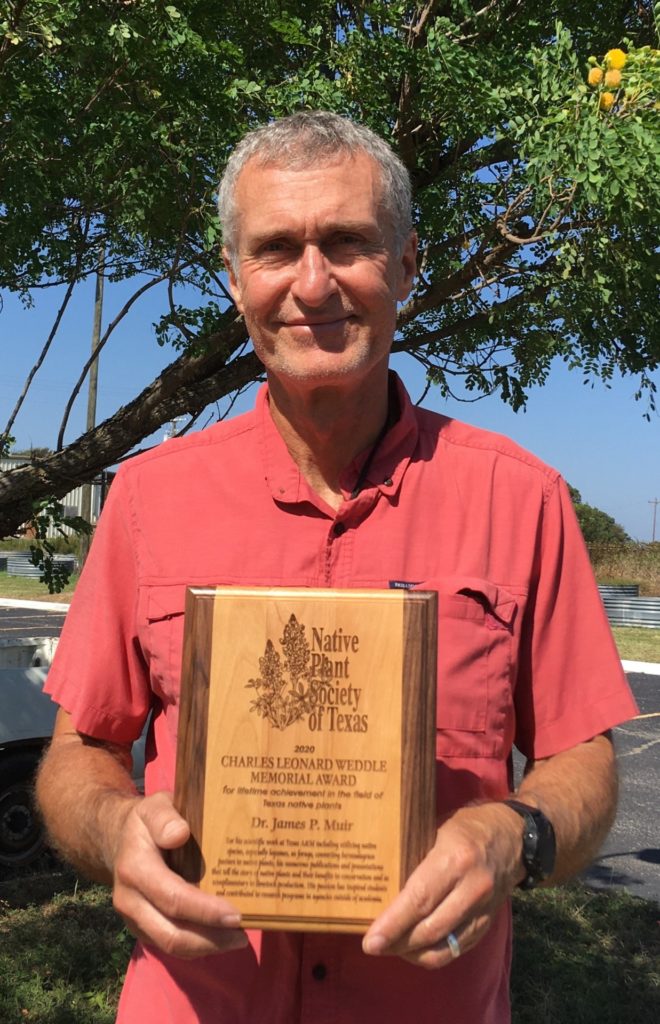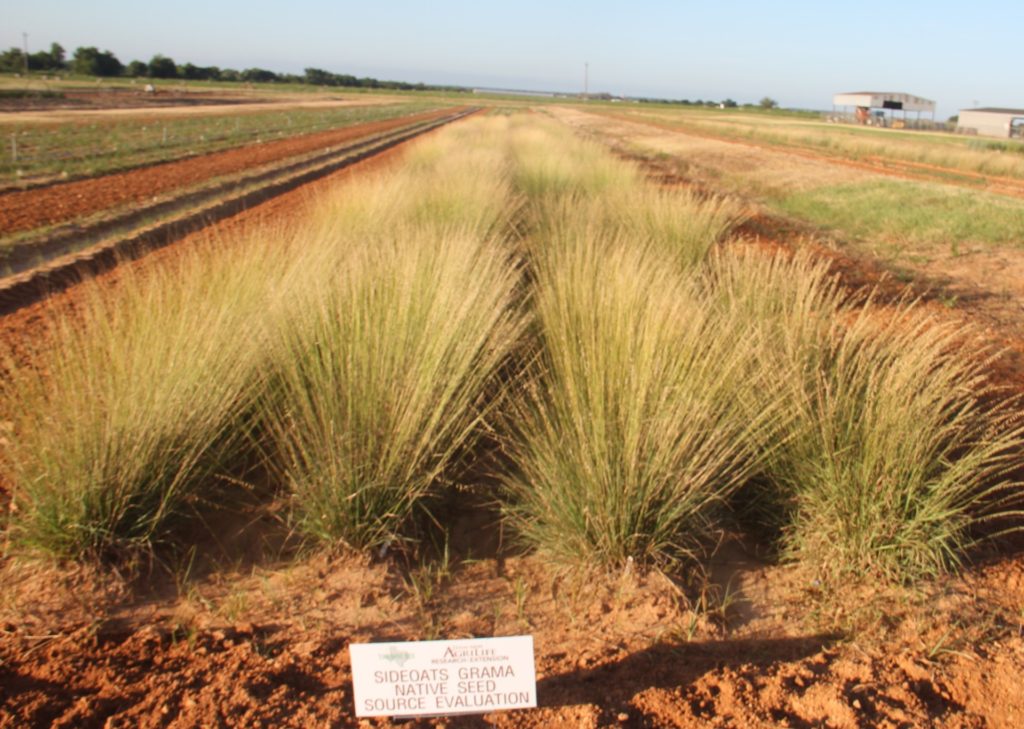Native Plant Society awards Muir for lifetime achievement
Texas A&M ecologist recognized as champion of native Texas plants, ecosystem restoration
The Charles Leonard Weddle Memorial Award is presented annually by the Native Plant Society of Texas for lifetime achievement in the field of Texas native plants. The most recent honoree is Texas A&M AgriLife Research’s James Muir.
Muir, Ph.D, is a grassland ecologist at the Texas A&M AgriLife Research and Extension Center at Stephenville, as well as a Regents Professor in Texas A&M’s College of Agriculture and Life Sciences Department of Soil and Crop Sciences and with Tarleton State University.

“Dr. Muir has been an active champion for native plants, and his research and scholarly activities have been incredible contributions for Texas grasslands and restoration efforts as well as having impacts across the world, in particular Africa and South America,” said Bill McCutchen, Ph.D., director of Texas A&M AgriLife Research and Extension Center at Stephenville.
Muir’s contributions to graduate education, research focusing on native plants and impactful conservation efforts statewide are what made Muir such a standout candidate, said Kim Conrow, president of the Native Plant Society of Texas.
“His passionate advocating for native plants and science-based promotion of their inclusion into Texas’ agriculture production pasture systems, especially native legumes, is outstanding,” Conrow said. “Muir’s recent scientific work dealing with native plants for converting Bermuda grass pasture to native prairie is of the utmost relevance to private landowners concerned about native plant conservation throughout the state.”
Muir explained that the Native Plant Society of Texas has been very important in “getting our prairies back, our native songbirds back and our quail back.”
He said he was pleased to learn he’d been recognized by the Native Plant Society.
“I’m pleased, not just for myself, but because it means Texas A&M AgriLife is doing its job when our stakeholders and groups recognize that we are working on their behalf to restore native ecosystems with native plants,” he said.
Education and path to Texas A&M
Muir’s journey with native plants began long before he came to the College of Agriculture and Life Sciences at Texas A&M.
“I had a passion for plants from an early age,” Muir said. “That ultimately led me to an interest in botany and related fields.”
Muir earned his master’s degree and doctorate in agronomy from the University of Florida, Gainesville. His undergraduate work was at Wheaton College in Illinois where he studied biology and ecology. After college, Muir worked as a Fulbright-Hays Fellow at Universidade Eduardo Mondlane, Mozambique, and then as a visiting agronomist to Instituto de Produção Animal, Mozambique.
He worked for the Ministry of Agriculture in Mozambique for a decade, and then in 1997 Muir moved his family to the U.S., where he joined Texas A&M as an assistant professor and member of AgriLife Research.
Muir’s professional research includes leading teams to collect, evaluate and release native herbaceous germplasm in Texas, Mozambique and Brazil; studying the impact of condensed tannins of herbaceous legume origin on ruminant nutrition, health and environment; and using native herbaceous germplasm for grassland and roadside revegetation.
Restoring native ecosystems for Texas
Muir’s passion is native legumes; and although they are somewhat scarce today in Texas, McCutchen said Muir’s collaborative work on native grasses has led to more diverse and environmentally stable ecosystems.
“With the rapid increase in Texas’ population, restoration management is required to facilitate conservation, diversification and sustainability for the state’s wildlife and agriculture,” McCutchen said.
Recently, Muir and his colleagues entered a new phase in collaboration with Texas A&M University-Kingsville and the Texas Native Seeds program, where they have developed a strategic plan for expanding their collective efforts.
“One of those areas now includes research for the adaptation of native plants in urban environments,” McCutchen said. “To put it simply, these natives look like Texas, and are very elegant in the landscape. Perhaps most of all, these plants are very drought, insect and disease tolerant, requiring significantly less inputs and attention by the home and business owner.”
Adapted for Texas
“When I came to Texas, there were very few adapted legumes for forage production,” Muir said. “That is in part because the climate in Texas is unique. We are neither tropical nor temperate, we are sort of sub-tropical or mixed.”
He said the extreme temperatures and rainfall patterns in Texas are relatively inconducive to legume growth.
“Our summers are very hot and dry, and our winters are very cold and dry,” he said. “We have a bimodal rainfall system, with a little bit of rainfall in the spring and fall. It is about the absolute worst climate you could dream up for plants.”
Given the difficult nature of the state’s climate, Muir decided his best chance for success was to work alongside Mother Nature.
“If nature has had millennia to produce germplasm to adapt to this crazy climate why would I try to go against that?”
Muir started collecting germplasm in Central Texas—mostly seeds but also plants. He examined them to see how productive they were, how nutritious they were for animals and what potential they might have for bioenergy use.
Thinking native
Initially Muir’s quest for researching native legumes was a relatively lonely one. He said many researchers were more interested in making clover or alfalfa, which are from Mediterranean regions, or other plants from tropical regions grow here—when none of these typically grow well in most of Texas.
Ultimately Muir found kindred souls at Texas A&M University-Kingsville.
“They were instrumental in helping me develop my program and now I work closely with their Texas Native Seeds program on the legume side of things,” he said.
Muir’s background in grassland ecology works well in Central Texas, where the land isn’t well adapted for row crops, but landowners—like those who lease hunting land, cattle ranchers and dairy farmers—are seeking expertise on native plants.
“We’ve also expanded into research on natives for pollinators and as ornamentals,” Muir said.
He said the benefits of native vegetation in Texas cannot be ignored. These are natives that don’t take a lot of maintenance, herbicide or water.
“It doesn’t matter if you’re in the city or country, or just interested in the land for recreation purposes or tourism, we live in a state where native vegetation matters,” Muir said.
McCutchen said that Muir’s determination and wealth of experience is an invaluable asset to Stephenville, the state of Texas and beyond.
“I am pleased that he is being honored for his ongoing work and am excited to see what the future holds,” McCutchen said. “The Native Plant Society of Texas recognizes his passion and innovative spirit in changing how Texan’s perceive our native plants. He is a true champion, in both words and deeds, for native plants. What an honor for him to receive this most prestigious award.”



